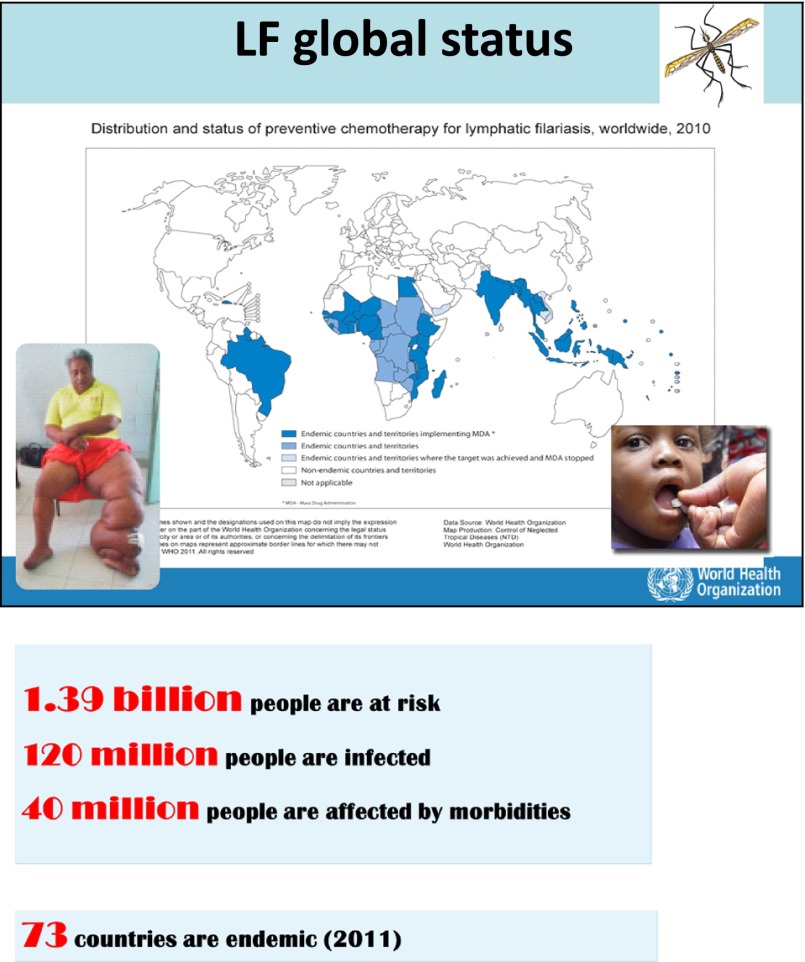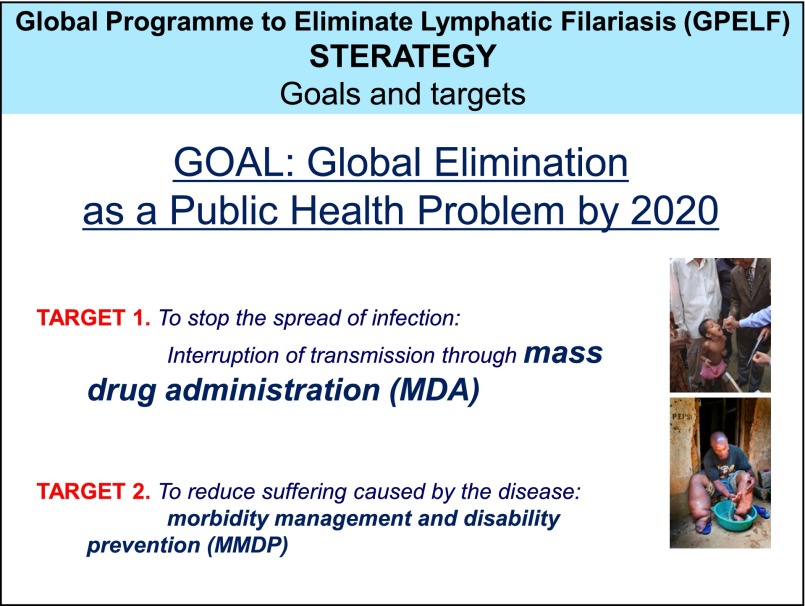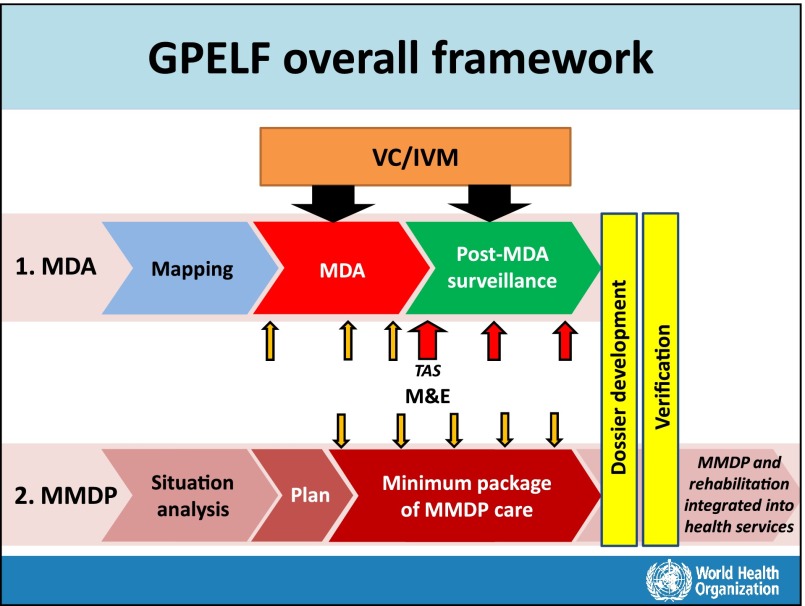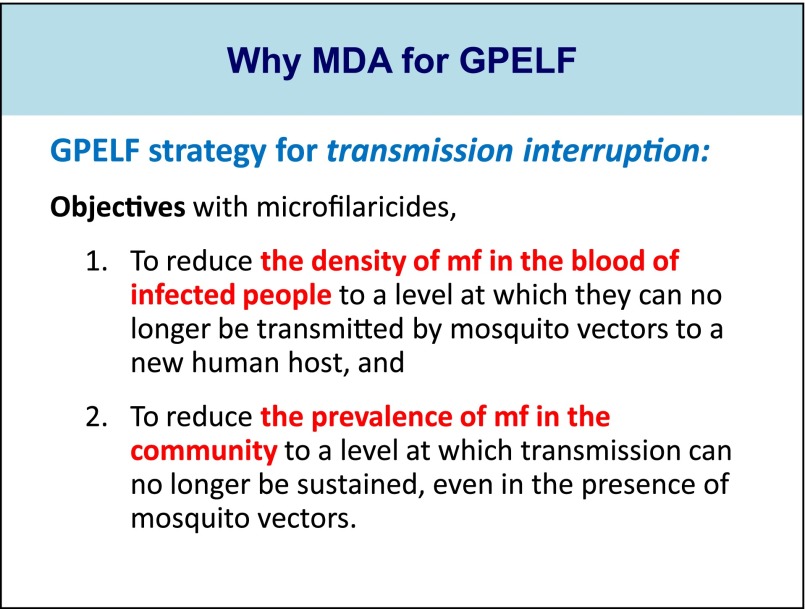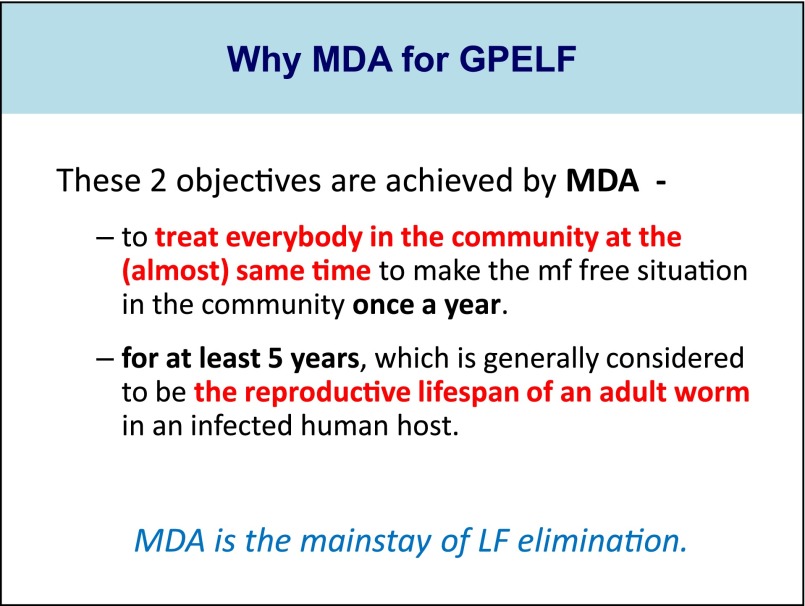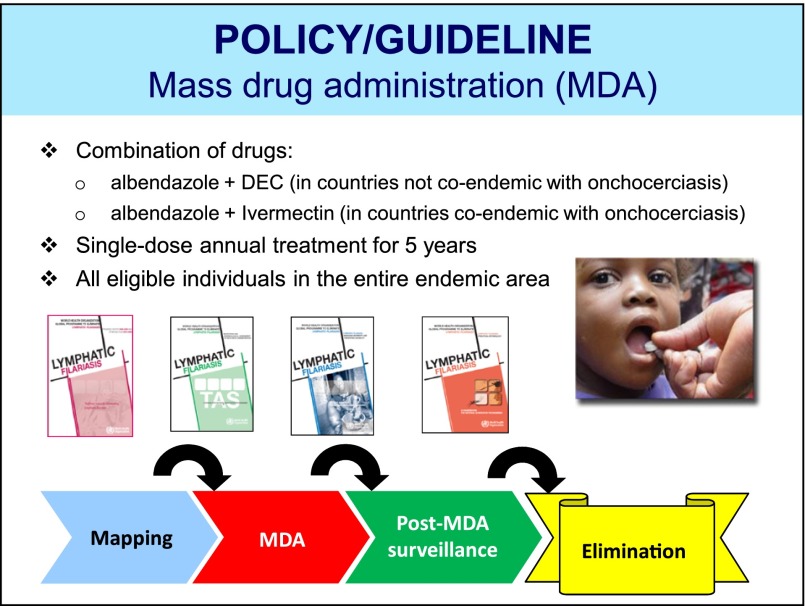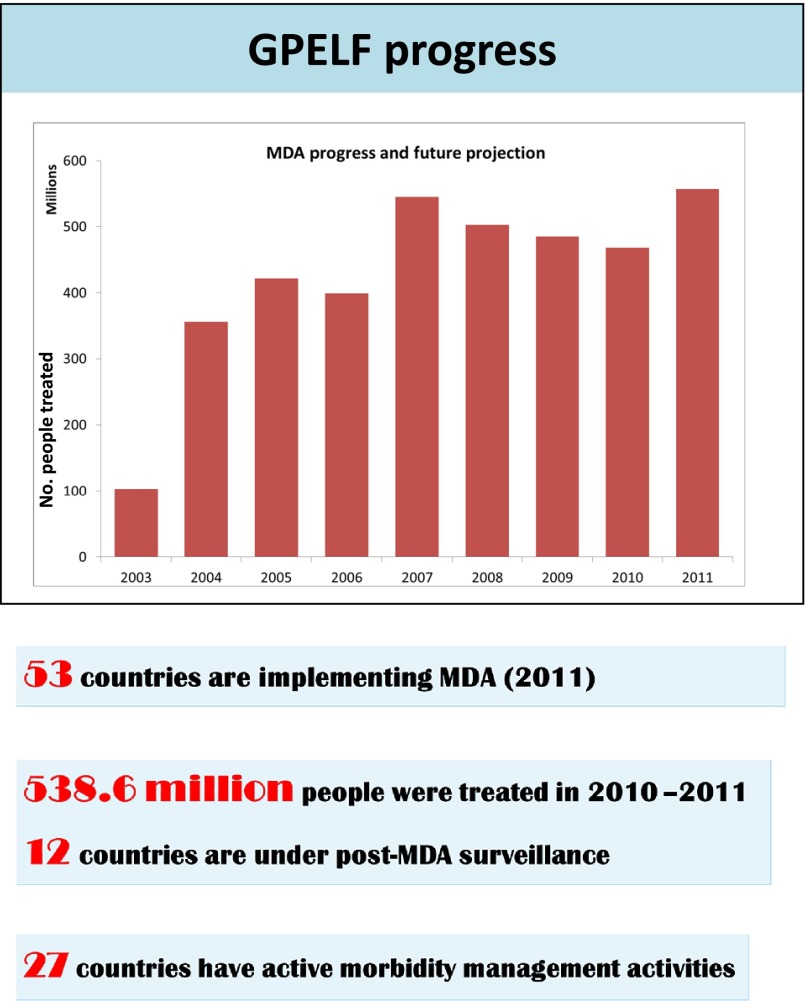Abstract
Lymphatic filariasis is one of the neglected tropical diseases. It is estimated that 120 million people are currently infected in 73 countries where filariasis is endemic. Lymphatic filariasis is a leading cause of chronic disability worldwide, including of 15 million people who have lymphoedema (elephantiasis) and 25 million men who have hydrocoele.
Keywords: Lymphatic filariasis, MDA, Global Programme to Eliminate Lymphatic Filariasis
The Global Programme to Eliminate Lymphatic Filariasis (GPELF) has been one of the most rapidly expanding global health programmes in the history of public health. The programme was launched in 2000 in response to resolution WHA50.29, with the goal to eliminate lymphatic filariasis as a public-health problem by 2020 (Fig. 1).
Fig. 1.
Global status
The GPELF has two strategic aims: (i) interruption of transmission, using combinations of two medicines delivered to entire populations at risk, a strategy known as mass drug administration (MDA); and (ii) morbidity management and disability prevention (MMDP), by providing access to basic care to every affected person in endemic areas (Fig. 2.).
Fig. 2.
Global elimination programme
The World Health Organization has developed a GPELF framework and guidelines for Member States to accelerate their efforts towards elimination of lymphatic filariasis by 2020 (Fig. 3).
Fig. 3.
Framework
The GPELF strategy for transmission interruption has two objectives with microfilariacide; the first one is to reduce the density of the microfilariae in the blood of infected people to a level at which they can no longer be transmitted by mosquito vectors to a new human host, and the scond one is to reduce the prevalence of microfilariae in the community to a level at which transmission can no longer be sustained, even in the presence of mosquito vectors. These two objectives are achieved by mass drug administration, MDA (Fig. 4).
Fig. 4.
Why MDA
MDA should cover everybody except children age below 2, pregnant women and very sick people in the community at the same time to make the microfilariae free situation in the community once a year. Then, MDA should continue for at least 5 years, which is generally considered to be the reproductive lifespan of an adult worm in an infected host (Fig. 5).
Fig. 5.
Perspective of MDA
The technical policies for MDA involve 1) combination of drugs, 2) single-dose annual treatment for 5 years and 3) to cover all eligible individuals in the entire endemic area (Fig. 6).
Fig. 6.
Technical policy
Of the 73 endemic countries, 53 are implementing MDA, and 12 have moved to the post-MDA surveillance phase. During 2000–2012, more than 4.2 billion doses of medicine were delivered to a cumulative targeted population of 979 million people (Fig. 7).
Fig. 7.
Progress
The first decade of GPELF was characterized by rapid scaling up of mapping and MDA. In addition, nine out of originally endemic countries at the start of GPELF were re-classified as non-endemic in 2010. A number of countries have even successfully moved up to the post-MDA surveillance stage. Intensified activities in the next five years will be essential to achieving the global elimination goal by 2020 (Fig. 8).
Fig. 8.

Global strategy
Questions and Discussion
Shinjiro Hamano Thank you very much Dr. Ichimori. Now, we open this for your comment or question to her. Professor Hirayama?
Kenji Hirayama Very big story about MDA. Somehow that is one of the models of elimination program and so that’s why following one, maybe some of the schisto or malaria. I think the big step from the PacELF to the global one, what were major difficulties or major challenge to scale up to the global levels, the medicine or… What was the issue at that time?
Kazuyo Ichimori Thank you very much. The PacELF is a Pacific program to eliminate lymphatic filariasis, is a part of the Global Programme. When I was in the Pacific, I mainly worked with the people for MDA implementation. After I moved to HQ I was in charge and looked after the global LF elimination programme. The challenge in the global level is—we have to develop the global policies and international standard guidelines for everybody in the world. It’s not only the Pacific areas but also any other areas we have to cover. Therefore, we should make very clear and core policies and basic guidelines which can be used by any countries. That’s what we are trying to do. Maybe, I am not answering to your question, but…
Kenji Hirayama Yes, country level involvement is really essential.
Jun Kobayashi Jun Kobayashi. I come from Japan Consortium for Global School Health Research. Thank you very much. Always, Dr. Ichimori presentation, we feel very strong passion for eliminations of filariasis. I have very simple question. I visit several countries for discussion not only filariasis MDA or soil-transmitted helminths MDA. When we can stop MDA? Of course, filariasis MDA is very effective for short span, but when we are thinking of long span, only MDA we can eliminate or we can eradicate. This is sure, because for soil-transmitted helminths, always we are thinking when we can stop MDA. This is a question come from each country. But, we have no clear answer, when we can stop. Maybe, for STH control, we have to do comprehensive package. They are effective. But for filariasis, maybe, MDA is effective I believe. This is a question. Do you have already evidence from some country what timing or stop MDA?
Kazuyo Ichimori For LF, as I said the transmission assessment survey guideline we have. That is kind of new survey tool or survey method showing how to stop MDA. We had a lot of research people’s idea and evidence for a survey method, and, we worked together to make a standard survey method and WHO made it as a survey guideline—which is Transmission Assessment Survey-TAS. Countries can follow the guidelines. If the countries have more than 5 times MDA with good coverage as 65%. and if the result of the sentinel site survey is below 1%, they have to consider the transmission assessment survey. The transmission assessment survey is a decision-making survey—it is a yes or no survey. If they pass this transmission assessment survey, they can stop MDA and then move to the post-MDA surveillance stage. If fail, they have to continue MDA. We believe that MDA for LF policy and guidelines including TAS is very clear.
Jun Kobayashi Thank you very much, but, maybe my question is not clear. Guideline for when stop MDA or filariasis come from evidence from simulation or evidence from some country experience, which one?
Kazuyo Ichimori Yes, all guidelines are based on the evidence including country’s experiences and research evidence, also the statisticians or epidemiologist ideas too. For TAS guideline, the research groups all over the world including groups supported by Gates Foundation created evidence. Then, we worked together to develop the guidelines using their evidence.
Jun Kobayashi So for STH also, there is a planning for making this kind of evidence?
Kazuyo Ichimori The STH have to do the similar way. As integrated operation, we are giving the drugs together in one package, but I think all diseases are different in epidemiology and biology, so therefore each disease has to have clear guidelines.
Jun Kobayashi Thank you very much. Very clear.



